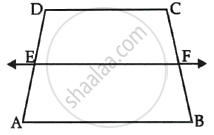Advertisements
Advertisements
प्रश्न
In the given figure, PQ || AB; CQ = 4.8 cm QB = 3.6 cm and AB = 6.3 cm. Find : If AP = x, then the value of AC in terms of x.
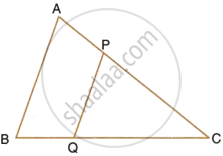
उत्तर
In ΔCPQ and ΔCAB,
∠PCQ = ∠ACB ...(Since PQ || AB, so the angles are corresponding angles)
∠C = ∠C ...(Common angle)
∴ ΔCPQ ∼ ΔCAB ...(AA criterion for similarity)
`=> (CP)/(AC) = (CQ)/(CB)`
`=> (CP)/(AC) = (4.8)/(8.4) = 4/7 `
So, if AC is 7 parts, and CP is 4 parts, then PA is 3 parts.
Given, AP = x
or 3 parts = x
`=>` 1 part = `x/3`
`=>` 7 parts = `(7x)/3`
Hence, AC = `(7x)/3`
APPEARS IN
संबंधित प्रश्न
E and F are points on the sides PQ and PR, respectively, of a ΔPQR. For the following case, state whether EF || QR.
PQ = 1.28 cm, PR = 2.56 cm, PE = 0.18 cm and PF = 0.36 cm
In ΔABC and ΔDEF, it is being given that: AB = 5 cm, BC = 4 cm and CA = 4.2 cm; DE=10cm, EF = 8 cm and FD = 8.4 cm. If AL ⊥ BC and DM ⊥ EF, find AL: DM.
In the figure, given below, the medians BD and CE of a triangle ABC meet at G. Prove that:
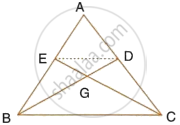
- ΔEGD ~ ΔCGB and
- BG = 2GD from (i) above.
The given figure shows a triangle PQR in which XY is parallel to QR. If PX : XQ = 1 : 3 and QR = 9 cm, find the length of XY.
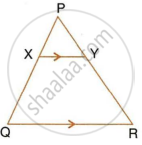
Further, if the area of ΔPXY = x cm2; find, in terms of x the area of :
- triangle PQR.
- trapezium XQRY.
In the given figure, ABC is a triangle and PQ is a straight line meeting AB in P and AC in Q. If AP = 1cm, PB = 3cm, AQ = 1.5cm, QC = 4.5cm, prove that area of ΔAPQ is 116 of the area of ΔABC.
The length of a river in a map is 54cm. if lcm on the map represents 12500m on land, find the length of the river.
In the following figure, point D divides AB in the ratio 3 : 5. Find :
DE = 2.4 cm, find the length of BC.
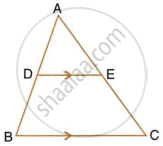
The scale of a map is 1 : 50000. The area of a city is 40 sq km which is to be represented on the map. Find: The length of a scale in km represented by 1cm on the map.
In Quadrilateral ABCD, side AD || BC, diagonal AC and BD intersect in point P, then prove that `"AP"/"PD" = "PC"/"BP"`
In the given figure, if ABCD is a trapezium in which AB || CD || EF, then prove that `(AE)/(ED) = (BF)/(FC)`.
